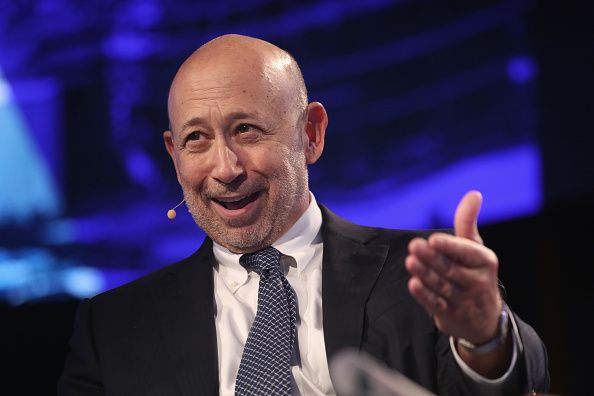
After 12-plus years at the helm of Wall Street heavyweight Goldman Sachs, chairman and CEO Lloyd Blankfein will be stepping down from his position, possibly as early as the end of 2018.
In light of the news that Goldman Sachs co-president Harvey Schwartz will be stepping down next month, co-president David Soloman is widely assumed to be named as Blankfein’s replacement, and he will serve as the firm’s sole president and COO moving forward.
Blankfein is carefully managing his own exit and will be going out on top, senior associate dean for leadership studies at the Yale School of Management Jeffrey Sonnenfeld told Chief Executive.
“Lloyd Blankfein’s 12-year career has been as superb a run as any financier has enjoyed, with just one or two bumps along the road,” Sonnefeld says. “Blankfein has skillfully guided the firm through some troubling times in financial markets, piloting it into soaring success. He is revered by his peers, competitors, clients and employees.”
The succession would allow the next CEO to build a legacy of their own at Goldman Sachs.
“This firm, while a public company now, still has a wonderful private partnership collegial ethic and is likely to want to give the next team a chance to take charge and build a legacy, as well,” Sonnenfeld says.
“Blankfein encouraged people to think more broadly about their business and their lives as they climbed the career ladder.” – Jeff Cunningham
While specifics on Blankfein’s exit timeline and his future role, if any, with Goldman Sachs have yet to be unveiled, the fact that he is calling the shots on his own departure and leaving a large window of time for transition is providing Wall Street with some comfort in the situation.
“[Blankfein] is no monarch relying on some late-life, feet-first exit,” Sonnenfeld says. “He is co-piloting this on his own schedule with no pressure or drama, which is why the stock market has reacted favorably but calmly. It is not clear whether he would leave the firm at year’s end or step down as day-to-day CEO to a chairmanship role.”
The 63-year-old Blankfein joined Goldman Sachs in 1982 and has served as chairman and CEO since 2006, steering the firm through the 2008 financial crisis and coming out a bit bruised, but still intact. Over the course of his career he managed Goldman Sachs’ Currency and Commodities Division, as well as its Fixed Income, Currency and Commodities Division and Equities Division.
Blankfein’s leadership style as CEO stands out among his peers, according to professor of leadership at Arizona State University’s Thunderbird School of Global Management Jeff Cunningham.
“Blankfein encouraged people to think more broadly about their business and their lives as they climbed the career ladder. It meant not just doing good things for others, however, which might sound a bit too schmaltzy for a Wall Streeter,” Cunnhingham told Chief Executive. “There was a second part he was conveying, which was the dictum to rebuild a partnership culture in the public company as a way to enhance your own sense of moral judgment. It is one in which you take responsibility for your actions and your partner’s, and subject them to a deep due diligence so that even as a public company, as Blankfein told me, ‘we carry our partnership culture into the public company so we have an ownership culture.’ Lloyd Blankfein devoted his career to letting the world he never forgot what matters.”

Chief Executive Group exists to improve the performance of U.S. CEOs, senior executives and public-company directors, helping you grow your companies, build your communities and strengthen society. Learn more at chiefexecutivegroup.com.
0

1:00 - 5:00 pm
Over 70% of Executives Surveyed Agree: Many Strategic Planning Efforts Lack Systematic Approach Tips for Enhancing Your Strategic Planning Process
Executives expressed frustration with their current strategic planning process. Issues include:
Steve Rutan and Denise Harrison have put together an afternoon workshop that will provide the tools you need to address these concerns. They have worked with hundreds of executives to develop a systematic approach that will enable your team to make better decisions during strategic planning. Steve and Denise will walk you through exercises for prioritizing your lists and steps that will reset and reinvigorate your process. This will be a hands-on workshop that will enable you to think about your business as you use the tools that are being presented. If you are ready for a Strategic Planning tune-up, select this workshop in your registration form. The additional fee of $695 will be added to your total.

2:00 - 5:00 pm
Female leaders face the same issues all leaders do, but they often face additional challenges too. In this peer session, we will facilitate a discussion of best practices and how to overcome common barriers to help women leaders be more effective within and outside their organizations.
Limited space available.

10:30 - 5:00 pm
General’s Retreat at Hermitage Golf Course
Sponsored by UBS
General’s Retreat, built in 1986 with architect Gary Roger Baird, has been voted the “Best Golf Course in Nashville” and is a “must play” when visiting the Nashville, Tennessee area. With the beautiful setting along the Cumberland River, golfers of all capabilities will thoroughly enjoy the golf, scenery and hospitality.
The golf outing fee includes transportation to and from the hotel, greens/cart fees, use of practice facilities, and boxed lunch. The bus will leave the hotel at 10:30 am for a noon shotgun start and return to the hotel after the cocktail reception following the completion of the round.